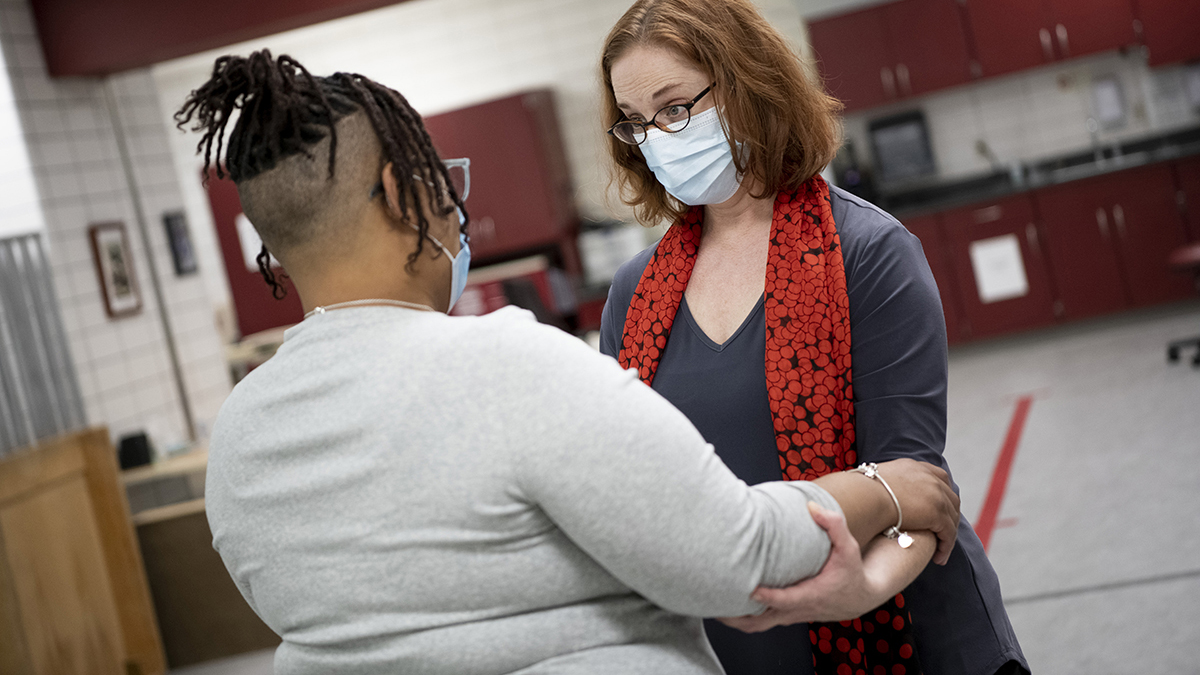The healing power of creative engagement
Lise combines art with neuroscience to develop novel therapies that improve lives

Nakia Bridges’ life changed without warning.
A corrections officer, Bridges was taking part in a self-defense demonstration when her head hit the floor twice, causing a massive concussion. In the nearly two years since, she has regularly experienced severe symptoms associated with post-concussion syndrome: memory loss, distorted vision and debilitating issues with balance and concentration, to name a few. Not to mention the financial challenges, anxiety and depression that come with forced medical leave from employment.
Her struggle has been hard. But every day she battles valiantly to get her life back.
Part of Bridges’ recovery process has been working with The Ohio State University’s Lise Worthen-Chaudhari, who develops therapies that unite artistic engagement with neuroscience to help people rehabilitate from neural impairments.
Her most recent therapy design is Tango for Concussion, which included a 12-week study funded by the Chronic Brain Injury Program discovery theme. Bridges was a participant.
“If it wasn’t for Lise, I wouldn’t be as steady as I am right now,” says Bridges, who is writing a book about her post-concussion battle. “I’ve been so determined to get back to being myself, and Lise’s tango has worked better than any other therapy I’ve had. We, as concussion patients, need more leaders like her.”
Bridges says that before the study, she struggled to stay balanced while walking and couldn’t listen to music or go into a grocery store without suffering massive headaches or anxiety attacks. Though she still struggles, tango therapy has helped Bridges regain balance and listen to her favorite gospel music again. It’s also improved her ability to focus.
“Nakia’s story is amazing, and her overcoming what happened is so inspiring,” says Worthen-Chaudhari, the associate director of Ohio State’s Motion Analysis and Recovery Biomechanics Lab. “The data so far indicate that each Ohio State client who took part in the study got to a better place through focused artistic work.”
A trained dancer and research specialist in biomechanics and physical rehabilitation, Worthen-Chaudhari has been a pioneer in harnessing artistic expression to engage the mind in therapeutic rehabilitation of cognitive motor skills. Her therapy designs have helped patients who have suffered such injuries as concussions, strokes, spinal cord injuries and even chemotherapy-induced impairments.
“Nobody asks for a brain injury or a stroke,” she says. “It involves tough work to journey out of that. I would argue it is a creative endeavor so you might as well use the creative process to get through it.
“Art isn’t just a hobby, it changes our system. Art matters because it has an impact at the physiologic level. And we can leverage that to ease suffering because the creative process is parallel to the neurological rehabilitation process.”
That’s not just a hypothesis either. Like Tango for Concussion, Worthen-Chaudhari’s therapies have a track record of success. In fact, Tango for Concussion combines results from two previous successful therapies: SuperBetter, a gaming app for concussion recovery, and It Takes Two to Tango, an intervention for cancer survivors struggling with walking and balance.
Two of her other accomplished therapies include Embedded Arts and Reveal, which were both developed for clinical use by the Columbus-based company Rekovo, for which Worthen-Chaudhari is the scientific advisor. Rekovo has documented the impact of her work.
“It’s every scientist’s dream to see these successes, and every artist’s dream too,” says Worthen-Chaudhari, who herself has suffered a concussion. “I really feel for those with brain injuries. And seeing patients smile and have those legit, ‘ah-ha’ moments is so motivating.”
And it’s important work. It’s been estimated half of the world’s population can expect to endure a brain injury in their lifetime. So whether it’s the person who suffers a head injury or their loved one, virtually everyone will come face-to-face with traumatic brain injury at some point.
And Worthen-Chaudhari says Ohio State embraces discovering solutions. When she arrived at Ohio State’s Department of Physical Medicine and Rehabilitation, Worthen-Chaudhari says former department chair Jerry Mysiw encouraged her to run with her novel ideas. Along the way, she’s received strong support and funding through the Chronic Brain Injury program and Pelotonia.
Another critical aspect is Ohio State’s emphasis on interdisciplinary research, which is at the core of her work.
“Team science can be super challenging, but if we want to improve someone’s quality of life, we have to accept that challenge to help the whole person,” she says. “Humans are complex beings so if we want to impact a person’s life, we have to apply holistic approaches.”